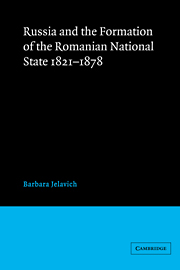Book contents
- Frontmatter
- Contents
- List of maps and illustrations
- Preface
- Introduction: The establishment of Russian influence in the Danubian Principalities
- I The Russian protectorate
- II The European guardianship
- III The Cuza era, 1859–1866
- IV Prince Charles, 1866–1871
- V Prince Charles, 1871–1878: the Eastern crisis
- Conclusion
- Notes
- Bibliography
- Index
- Plate section
Introduction: The establishment of Russian influence in the Danubian Principalities
Published online by Cambridge University Press: 18 December 2009
- Frontmatter
- Contents
- List of maps and illustrations
- Preface
- Introduction: The establishment of Russian influence in the Danubian Principalities
- I The Russian protectorate
- II The European guardianship
- III The Cuza era, 1859–1866
- IV Prince Charles, 1866–1871
- V Prince Charles, 1871–1878: the Eastern crisis
- Conclusion
- Notes
- Bibliography
- Index
- Plate section
Summary
Although Russian influence over political life in the Principalities did not become firmly established until the Treaty of Kuchuk Kainardji in 1774, Russian actions were already playing an important role in their internal development at the beginning of the eighteenth century. The main direction of the policy of Peter the Great was toward the Baltic rather than the Black Sea, but he had early in his career also shown an interest in expansion southward toward the Black Sea and, in particular, in the acquisition of Azov. The entire question of Russian relations with the Ottoman Empire became especially acute when in 1709, after his defeat at Poltava, Charles XII of Sweden fled to Constantinople and there, with French assistance, attempted to stir the Porte into action. His efforts met with success, and in 1711 the Ottoman Empire declared war on Russia.
Within the Principalities the Russian victory over the Swedish king made a deep impression. The temptation was strong to enter into relations with the Russian court in an attempt to break the Ottoman control over the Principalities. Accordingly, both Constantine Brincoveanu, the prince of Wallachia, and Dimitrie Cantemir, the ruler of Moldavia, opened negotiations with Peter. In April 1711 Cantemir and Peter concluded the Treaty of Luck. This pact of mutual assistance placed Moldavia under Russian political control; the terms stated that Cantemir, the boyars, and all of the Romanian population would henceforth be considered the Russian ruler's faithful subjects. Other sections of the treaty guaranteed Cantemir's personal and political future.
- Type
- Chapter
- Information
- Publisher: Cambridge University PressPrint publication year: 1984



